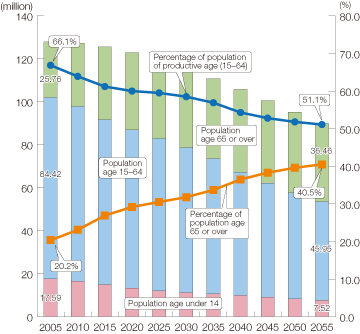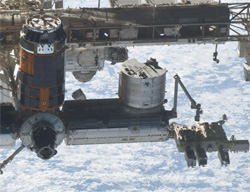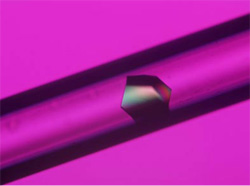Home > Highlighting JAPAN > Highlighting Japan JUNE 2012 > Life Innovation for the World
Highlighting JAPAN
COVER STORY: Life Innovation for the World
Life Innovation for the World

Japan's Population—Present and Future
Source: White Paper on Health, Labour and Welfare, 2011
Aging societies with decreasing numbers of children face the need to address the continuously rising number of citizens in need of medical and nursing care while the labor population continues to decrease. Innovative medical technologies need to be developed and new growth industries need to be cultivated to suit this aging society and ensure a future with healthy lives for Japan's elderly while maintaining a fiscal balance. For this purpose, the Japanese government has positioned a health power strategy through "life innovation" as one of seven strategic sectors in the New Growth Strategy approved by the Cabinet in June 2010. The strategy aims to realize a strong economy, robust public finances and strong social security system. Life innovation refers to innovation in the medical and nursing care sectors. The New Growth Strategy emphasizes that, "The aging of society in Japan, which has progressed farther than anywhere else in the world, poses an opportunity for developing new manufacturing industries and service growth industries by vigorously promoting 'life innovation.'"
Aging of society and a declining birthrate are not issues unique to Japan. Western and other Asian countries are also predicted to have aging progress with a continually declining number of children. This means that outcomes in life innovation in Japan can be shared abroad.
This month's Cover Story focuses on diverse efforts being made to realize life innovation in Japan. In the first part of the story, the Japan Journal's Sawaji Osamu reports on research in space medicine.

Japan's Kibo laboratory on the ISS
Credit: COURTESY OF JAXA/NASA
One of these involves space medicine. Astronauts live in an environment different from that of Earth, characterized by microgravity, enclosed space and exposure to space radiation, and this affects the human body in diverse ways. Space medicine aims to minimize these effects.

Astronaut Satoshi Furukawa exercises on the CEVIS (Cycle Ergometer with Vibration Isolation) machine in the ISS, July 2011.
Credit: COURTESY OF JAXA/NASA
"The bone density of an astronaut decreases by 1.5% each month; about 10 times faster than for osteoporosis patients," says Hiroshi Ohshima, manager of the Space Biomedical Research Office of the Japan Aerospace Exploration Agency (JAXA). "The mass of the calf muscle also decreases, by about 1% each day, which is equivalent to the age-related loss of muscle mass over six months for over sixties. We can say that space travel provides an accelerated model of the bodily changes caused by aging."
Scientists from Japan and the United States conducted a joint experiment aimed at preventing bone mass decrease. Eight astronauts, including Japanese astronauts, took an osteoporosis medication once a week in addition to exercising daily onboard, and measured the change in their bone mass before and after the long term space flight. The interim study results, presented at a Human Research Program Investigator's Workshop held at Houston in February 2012, indicated an average decrease in bone mass of the femur neck from the five test subjects who have completed post-flight data collection was almost zero. In other words, risks of bone mass reduction can be alleviated if effective measures are carried out. "Thus far, osteoporosis medicines have only been administered for treatment, but this study indicates their preventive effects are also very high," Ohshima says.

High-quality protein crystals generated in space
Credit: COURTESY OF JAXA
Making Protein Crystals
One of the experiments Japanese scientists are conducting in the ISS in the area of space medicine is generation of protein crystals. One of the purposes is drug development. Protein is generated within cells and works in various ways essential for everyday activities. However, protein that has for some reason lost its intrinsic functions will cause disease. Treatment medicines link with the abnormal protein, and terminate or normalize its functions, in a process often likened to a key and a keyhole. In other words, the three-dimensional structure of a protein (keyhole) should be clarified and a medicine (key) that fits it should be developed.
In order to clarify the three-dimensional structure of protein it is essential to create high-quality protein crystals that are free of distortion. It is difficult to generate high-quality crystals on Earth in a solution for developing protein crystals because gravitational pull causes convection flow and sedimentation. Objects in the ISS under microgravity, however, do not float or sink due to weight differences. This suppresses convection and sedimentation in the solution, and protein crystals of extremely high quality can be developed.
The Japanese scientists have conducted experiments at an ISS facility in Russia since 2003 and in Kibo since 2008 using protein crystal generation devices.

Astronaut Satoshi Furukawa installs the Cell Unit for the incubation of proteins in the Protein Crystallization Research Facility aboard Kibo, June 2011.
Credit: COURTESY OF JAXA/NASA
Thus far, JAXA has attempted to generate a total of 600 types of proteins in the ISS. These include proteins that could lead to development of treatment medicines. One example is H-PGDS, a protein that relates to Duchenne muscular dystrophy (DMD). This is an intractable disease said to occur in one out of every 3,500 boys. Patients' muscles undergo atrophy and necrosis, relegating the patients to needing wheelchairs and artificial respirators in their daily lives. The precise three-dimensional structure has been analyzed and candidate compounds have been made based on outcomes of crystal generation conducted five times in the ISS. The compound was administered to mice affected by DMD and demonstrated effects of halting muscular necrosis.
Needless to say, intractable diseases are not the only possible application. Another example is the creation of protein crystals that perform the central roles in the growth of the influenza virus. Based on data from experiments conducted four times thus far in the ISS, pharmaceutical manufacturers have worked to develop a drug that suppresses growth of the influenza virus.
High-quality crystals have also been successfully generated for proteins related to obesity, cancer and other diseases, and work is underway for clarifying their three-dimensional structure.
"We hope that not only Japanese research institutes but also those around the world will utilize Kibo as a crystal generation facility for high-quality proteins," Kobayashi says. "There are many world-leading 'super'-scientific facilities in Japan, including Spring-8, SACLA and the K computer. By connecting the outcomes obtained at these facilities and at Kibo, we hope to greatly contribute to the field of life innovation."
© 2009 Cabinet Office, Government of Japan






